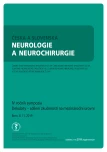Mapping of pressure ulcers and non-healing wounds in medical curriculum
Authors:
M. Komenda 1; J. Ščavnický 1; A. Pokorná 1,2
Authors‘ workplace:
Institut biostatistiky a analýz, LF MU, Brno
1; Katedra ošetřovatelství a porodní asistence, LF MU, Brno
2
Published in:
Cesk Slov Neurol N 2019; 82(Supplementum 1): 33-36
Category:
Original Paper
doi:
https://doi.org/10.14735/amcsnn2019S33
Overview
Aim: The issue of pressure ulcers and other non-healing wounds has been significantly underestimated in physicians’ pre-gradual training for clinical practice. This contribution is focused on mapping of current status of the General Medicine study programme at the Masaryk University with regard to the topic of pressure ulcers and non-healing wounds. A set of key concepts that cover the topic has been defined in the cooperation with Czech healthcare experts.
Methods: Analytical mapping of medical curriculum was based on frequency analysis of textual description of curriculum and pre-defined set of key concepts. Analytical steps were performed using the computing environment R and MS Excel. The aim is to identify related parts of the education programme by means of appropriate analytical methods and find eventual recommendations for the curriculum innovation.
Results: The resulting report in a form of summary tables and charts identifies the spots of interest within the curricula of individual disciplines, which will lead to the improvement of education in the field of pressure ulcers and other non-healing (chronic) wounds.
Conclusion: it was proven that attention is paid to the issue of non-healing wounds in the medical curriculum of undergraduate medical training at the Faculty of Medicine of Masaryk University in various years of study, both in preclinical and clinical medical disciplines. Within an increasing year of study there was identified higher number of teaching units and the hours containing key terms pressure ulcers and non-healing wounds.
Keywords:
pressure ulcer – non-healing wound – leg ulcer – medical curriculum mapping
Sources
1. Komenda M, Schwarz D, Vaitsis C et al. OPTIMED Platform: curriculum harmonisation system for medical and healthcare education. Stud Health Technol Inform 2015; 210 : 511–515.
2. Harden RM. AMEE Guide No. 14: Outcome-based education: part 1 – an introduction to outcome-based education. Med Teach 1999; 21(1): 7–14. doi: 10.1046/ j.1467-2494.1999.181696.x.
3. Rajman M, Besançon R. Text mining: natural language techniques and text mining applications. Data Mining and Reverse Engineering 1998 : 50–64. doi: 10.1007/ 978-0-387-35300-5_3.
4. Pokorna A, Benesova K, Muzik J et al. The pressure ulcers monitoring in patients with neurological diseases – analyse of the National register of hospitalized patients. Cesk Slov Neurol N 2016; 79/ 112: S8–S14. doi: 10.14735/ amcsnn2016S8.
5. Antalová N, Pokorná A, Hokynková A et al. Factors influencing recurrence of the pressure ulcers after plastic surgery – retrospective analysis. Cesk Slov Neurol N 2018; 81/ 114 (Suppl 1): S23–S28. doi: 10.14735/ amcsnn2018s23.
6. Stryja J, Turoň J. Léčba ran – farmakoekonomická data z pohledu poskytovatele a plátce péče. Cesk Slov Neurol N 2017; 80/ 113 (Suppl 1): S18–S20.
7. Kapp S, Santamaria N. The financial and quality-of-life cost to patients living with a chronic wound in the community. Int Wound J 2017; 14(6): 1108–1119. doi: 10.1111/ iwj.12767.
8. Kapp S, Miller C, Santamaria N. The quality of life of people who have chronic wounds and who self-treat. J Clin Nurs 2018; 27(1–2): 182–192. doi: 10.1111/ jocn.13870.
9. Olsson M, Järbrink K, Divakar U et al. The humanistic and economic burden of chronic wounds: a systematic review. Wound Repair Regen 2019; 27(1): 114–125. doi: 10.1111/ wrr.12683.
10. Yim E, Sinha V, Diaz SI et al. Wound healing in US medical school curricula. Wound Repair Regen 2014; 22(4): 467–472. doi: 10.1111/ wrr.12198.
11. Pokorná A, Leaper D. Assessment and documentation of non-healing, chronic wounds in inpatient health care facilities in the Czech Republic: an evaluation study: an evaluation study. Int Wound J 2015; 12(2): 224–231. doi: 10.1111/ iwj.12372.
12. White-Chu EF, Le T, Cordrey R. Implementing a chronic wound care workshop for internal medicine residents. Adv Skin Wound Care 2019; 32(2): 85–87. doi: 10.1097/ 01.ASW.0000549609.21974.6f.
13. Saibertová S, Pokorná A. Evaluation of the assessment and documentation of chronic wounds in residential social care in the Czech Republic. J Wound Care 2016; 25(11): 662–669. doi: 10.12968/ jowc.2016.25.11.662.
14. Cheng HY, Davis M. Geriatrics curricula for internal and family medicine residents: assessing study quality and learning outcomes. J Grad Med Educ 2017; 9(1): 33–45. doi: 10.4300/ JGME-D-16-00037.1.
15. Friman A, Wiegleb Edström D, Edelbring S. Attitudes and perceptions from nursing and medical students towards the other profession in relation to wound care. J Interprof Care 2017; 31(5): 620–627. doi: 10.1080/ 13561820.2017.1336991.
16. Pokorná A, Štrombachová V, Mužík J et al. Národní portál Systém hlášení nežádoucích událostí. Praha: Ústav zdravotnických informací ČR 2016. [online]. Dostupné z URL: https: / / shnu.uzis.cz.
Labels
Paediatric neurology Neurosurgery NeurologyArticle was published in
Czech and Slovak Neurology and Neurosurgery

2019 Issue Supplementum 1
Most read in this issue
- Quality of life in patient with non-healing wounds
- The knowledge and practises of nurses in the prevention of medical devices related injuries in intensive care – questionnaire survey
- The use of negative pressure wound therapy for wound complication management after vascular procedures
- Negative wound pressure therapy in treatment of a pressure ulcer in paraplegics
